Bangkok Patana


WELL-BEING

LEARNING

GLOBAL CITIZENSHIP































Best
Best
Best









GLOBAL CITIZENSHIP































Best
Best
Best




Ms Tracy Mayhead, Computing Teacher
It’s a pleasure to write the foreword for this month’s Bangkok Patana Magazine
As a new teacher who joined in August, I’ve spent my first few months at Bangkok Patana School getting to know a new community and adapting to life in Thailand. Having previously taught for several years in the UK, this is my first international post, and my first time in Thailand, making everything both new and exciting in equal measure.

Thailand is often called ‘The Land of Smiles,’ and I’ve certainly experienced the warmth and friendliness that the country is known for. The school provided an informative and fun induction programme, and my colleagues have been incredibly supportive and approachable. I’ve also been struck by how hardworking and polite the students are here at Bangkok Patana, one particular Year 7 student even took the time to show me to the Sports Hall when I asked for directions. The parents have been equally welcoming, offering help and sending friendly messages. Outside of school, I’ve had similar experiences,
such as the local market seller who is patiently teaching me to count the fruit in Thai.
Living in Thailand so far has been a blend of the unexpected and the wonderful. The rich mix of sights, sounds, and smells is something I’m still getting used to, but it’s fascinating to explore. I also feel fortunate to work in a school with such impressive facilities and beautiful grounds. The greenery and open spaces on campus have made it a pleasant environment to settle into.
Becoming part of the school community has been a highlight for me. Participating in the Patana Fun Run was a great way to meet new people. Though some of us ended up running
a bit further than planned, sharing a laugh about it afterwards made it all worthwhile. I’ve also joined the Vex Robotics ECA and have been amazed by the creativity and problem-solving skills of our students. Seeing them put these skills to the test at their first competition was impressive.
Another project I’m looking forward to is the cross-curricular project with Year 7, where we’ll focus on developing students’ independence and problemsolving abilities. Given the challenges we face globally, helping students understand their role in working towards a sustainable future is key. At my previous school, I was involved in a British Council project related to the sustainable development goals, so I am delighted to continue this work. I believe projects like these will equip students to think critically and take meaningful action.
As I continue to learn more about life in Thailand and at Bangkok Patana School, I am grateful for the warm welcome I’ve received and look forward to contributing to the school community and growing alongside my students and colleagues.
643 Lasalle Road (Sukhumvit 105)
Bangna Tai, Bangna
Bangkok 10260 Thailand
Tel: +66 (0) 2785 2200
Email: reception@patana.ac.th www.patana.ac.th
Editor: Sneha Mathew
Tel: +66 (0) 2785 2411
Email: snma@patana.ac.th
Advertisement: Finn Balslev
Tel: 081-866-2577
Email: finn@scandmedia.com
Design & Production: Scand-Media Corp., Ltd.
Tel: +66 (0) 2943 7166-8 www.scandmedia.com
Bangkok Patana Magazine is the termly publication of Bangkok Patana School published three times per year and distributed to 2,000 members of the School community. Reproduction of articles, artwork and illustrations by written permission only. This magazine is printed on recycled paper.
• Bangkok Patana School


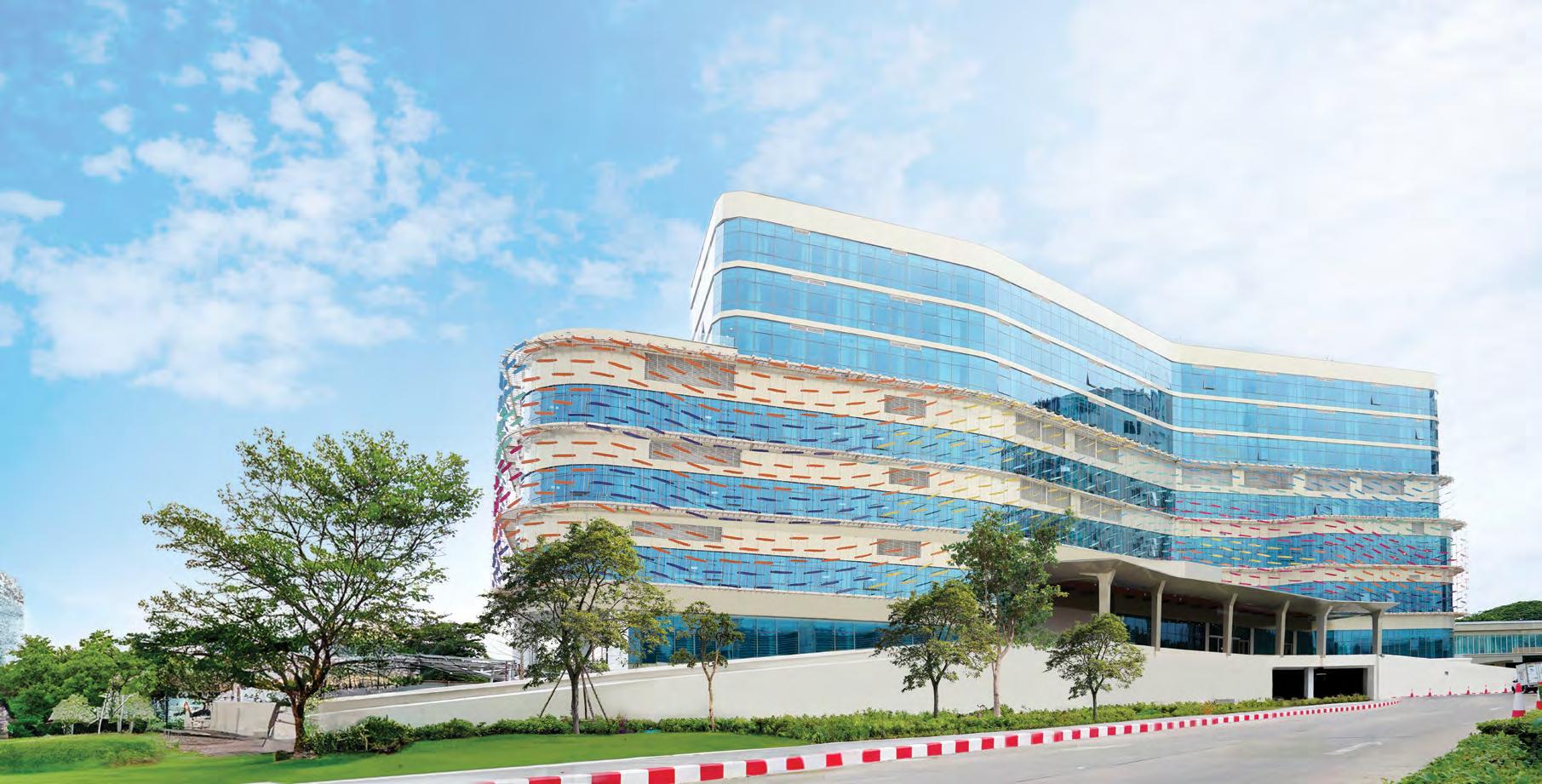



Patana Magazine interviewed our Head Chefs – Chef Pavinee (Bell) Sopakdee in the Secondary Canteen and Chef Pongsri Rungruengcharoenkul in the Primary Canteen
1.What are the main differences in planning meals for Primary versus Secondary students?
While the overall menu for Primary and Secondary students is similar, adjustments are made to cater to their age differences. Primary students are not served spicy foods, whereas Secondary students can enjoy dishes with a bit more spice. Additionally, nuts are excluded from primary canteen dishes to accommodate allergies, while Secondary dishes may include nuts but are clearly labeled for students with allergies. Portion sizes, particularly for proteins, are smaller in the Primary canteen to suit younger students, while Secondary students receive larger portions to meet their nutritional needs.
2.What’s the most popular dish among the students, and why do they love it?
Popular dishes include grilled meats, noodle-based meals, lasagna and spaghetti, which combine comforting flavours with nutritional balance. These meals appeal to students because they are familiar, hearty, and satisfying, offering a variety of textures and flavors. The combination of familiarity and taste means these dishes are enjoyed by students across different age groups.
3.How do you accommodate students with dietary restrictions or allergies?
For children in Nursery to Year 2 with dietary restrictions or allergies, we prepare special dishes and snacks. For others, in the Primary canteen, common allergens like gluten, dairy, egg and soy are clearly labeled and both canteens provide signage indicating the type of protein or meat used in each dish.
4.What new trends or ideas are you incorporating into the menu to keep it exciting?
To keep the menu fresh, new dishes are introduced each year. In the Secondary canteen, live cooking is offered once a week, featuring items like grilled steak, pizza, wraps, spaghetti and burgers. Additionally, external food options such as sushi, dim sum and kebabs are occasionally brought in to provide variety and excitement.
5.How do you balance offering comfort foods with healthier options?
We balance comfort foods with healthier choices by offering a varied buffet that includes meats, carbohydrates, lean meats, vegetables and dishes prepared with less oil. A daily salad bar and dedicated vegetarian menu ensure nutritious options are always available, providing students with both comfort and healthy eating choices.
6.What challenges do you face when preparing meals for a large number of students daily?
One of the main challenges is accurately forecasting demand for each dish. While meal quantities are based on the popularity of items, it’s not always possible to predict exact amounts. To address this, alternative options are always available in case certain dishes run out, ensuring meal service continues smoothly.
7.How do you source ingredients and do you focus on using local or sustainable products?
We source ingredients from trusted suppliers, including national
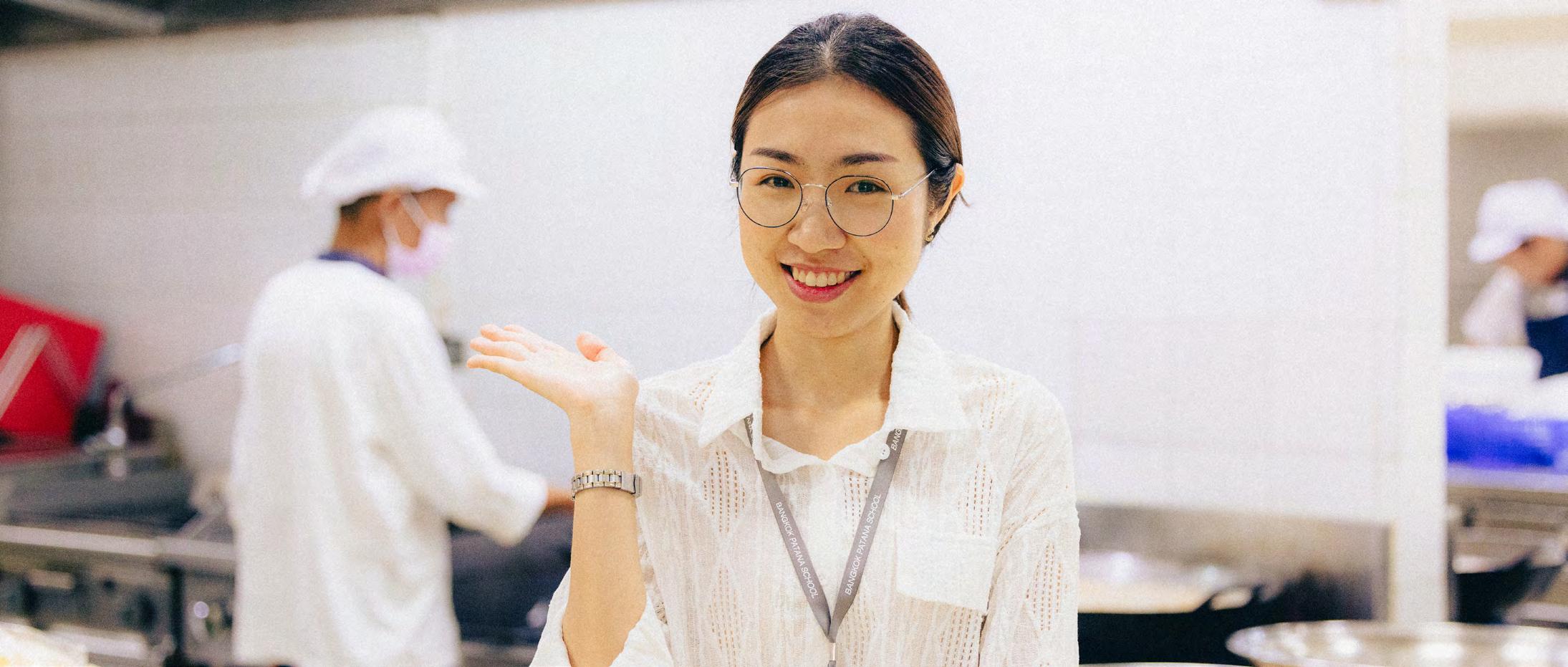
level producers for meats and local markets for vegetables and fruits. Additionally, we focus on sustainability by donating leftover food to the Scholars of Sustenance Foundation (SOS), which redistributes it to communities in Bangkok.
8.How do you incorporate seasonal ingredients into the school menus?
Seasonal fruits and vegetables are included in the salad bar, snacks and bakery items. This gives students fresh and varied produce throughout the year.
9.What strategies do you use to encourage students to try new or unfamiliar foods?
We promote new and unfamiliar dishes through canteen displays and online platforms like student notices and Patana News. New items are introduced in limited quantities to gauge student interest, making it easier to assess the popularity of different dishes.
10.How do you manage food waste in the canteen and are there any initiatives to reduce it?
Food waste is managed by separating it and coordinating with local authorities for collection. In Primary, portions are moderated, and students are encouraged to ask for more if needed, minimising waste. In Secondary, students serve themselves, allowing them to take only what they can eat. Food waste is also used in organic waste processing projects.
11.What role does student feedback play in shaping the canteen’s menu?
In Primary, feedback is shared through the Student Representative Council, while in Secondary, it’s gathered via the SSRC
(Secondary School Representative Council). This input helps us adapt the menu to student preferences.
12.
How do you stay up to date with the latest developments in child and adolescent nutrition?
We rely on our registered nutritionist Khun Supattana (Cherry) Pattanaprasert, employed full-time at school who collaborates with chefs to create healthy menus. Khun Cherry stays informed by attending conferences, taking online courses through the Thai Dietetic Association and Ministry of Public Health, and following guidelines from organizations like the WHO, BDA, and CDC.
13.What is the difference between Primary and Secondary eating habits?
Yes, in Primary, students often follow their peers’ eating choices. Secondary students, despite enjoying fried foods, tend to eat more colourful vegetables. They are also increasingly open to trying new menu items.
14.How do you create a balance between international cuisine and familiar local dishes?
Typically, the menu is split equally between Western and Asian cuisine, providing a variety of familiar and new options for everyone.
15.What is the most rewarding part of being a head chef in a school canteen?
The most rewarding aspect is seeing students and staff enjoy the food. Knowing that our meals contribute to their well-being and create a positive dining experience is especially fulfilling.



29th September 2024

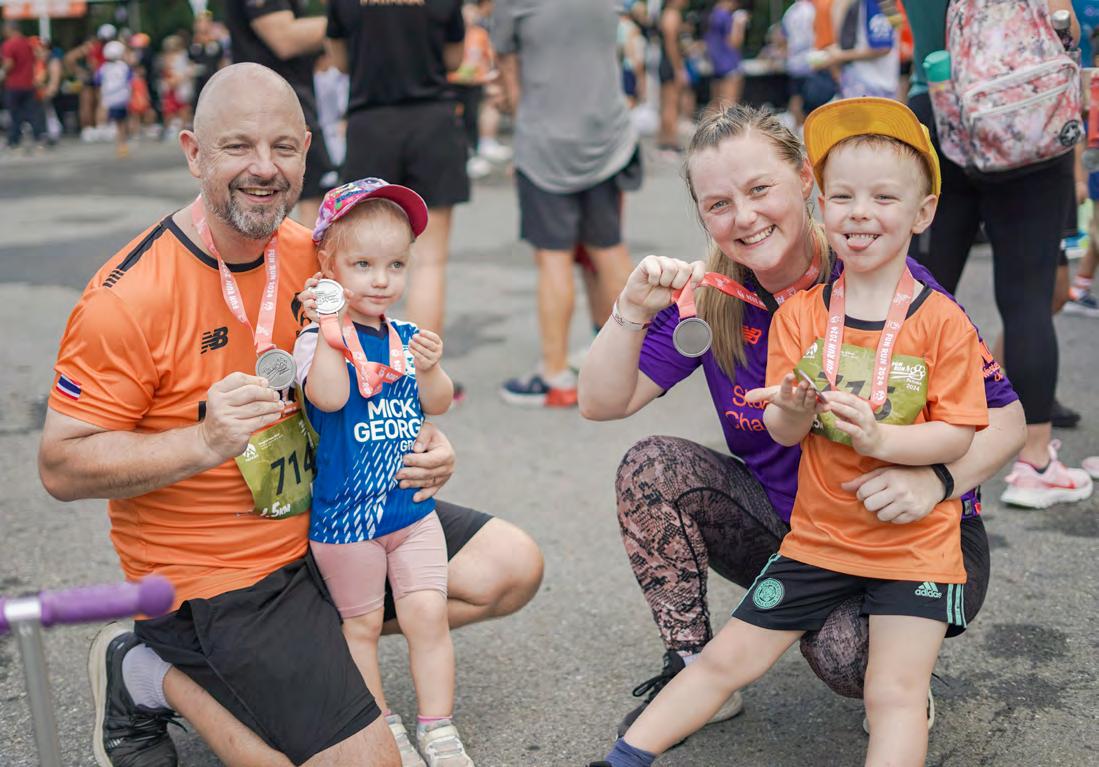











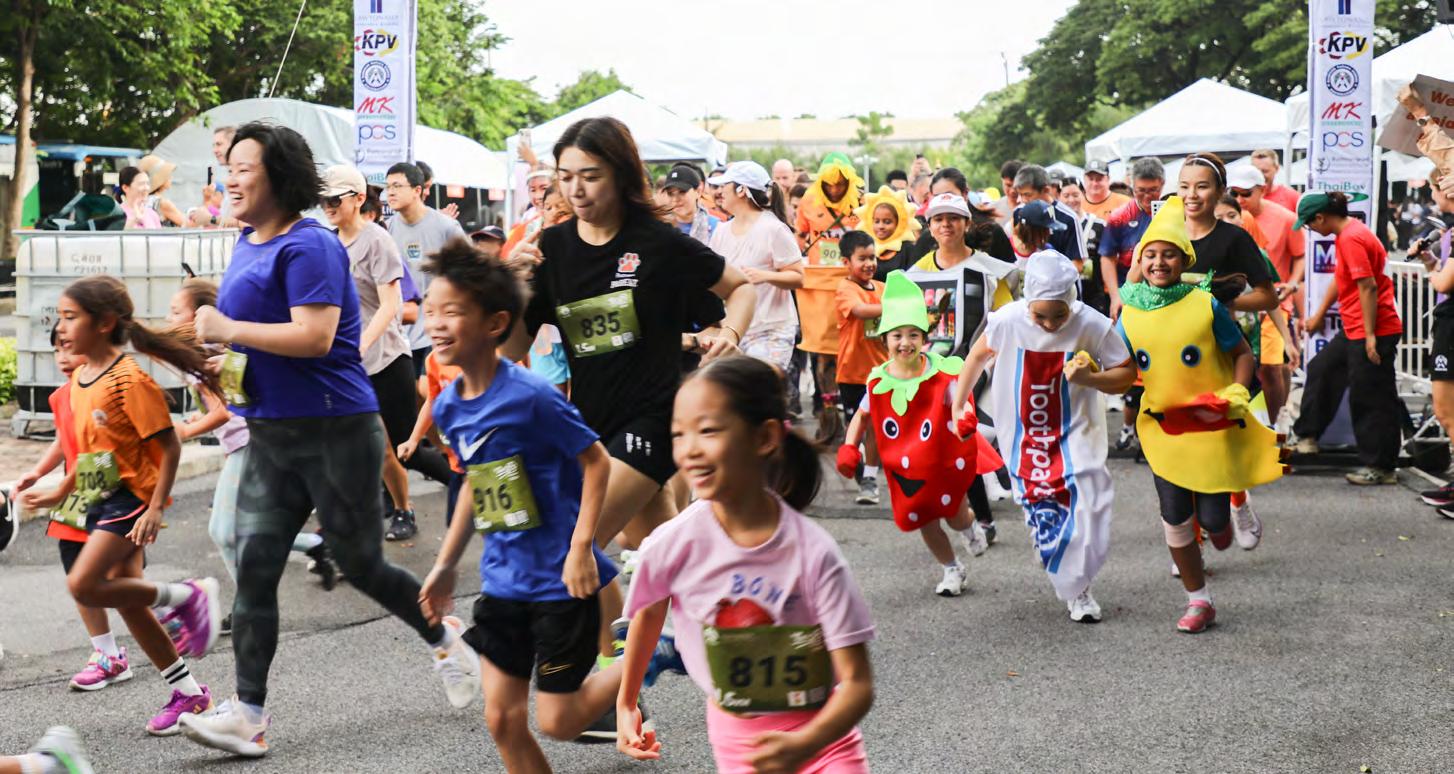

By Purnima Ghogar Ruanglertbutr TAPs Project Lead | Secondary English Teacher
At the core of our school community is a deep commitment to fostering lifelong learning, well-being, collaboration, inclusivity and creativity. With these values in mind, the Teachers as Arts Practitioners (TAPs) Continued Professional Learning (CPL) Programme at Patana has been launched.
TAPs refers to teachers who engage in artistic practices either professionally or as a hobby, integrating their artistic pursuits outside the classroom into their teaching ethos and seeing both as complementary to their ‘artist-teacher’ identity. Much research demonstrates the invaluable impact that artists in schools have on students: current engagement in the arts fosters personal well-being, strengthens community connections and enriches pedagogical approaches.
Launched in May 2024, the TAPs Project is a whole-school programme designed to empower business and academic staff to embrace their creative hobbies or professional engagement in the arts. Through curated exhibitions, TAPs celebrates staff artistic talents, fostering creative practices and cross-disciplinary connections regardless of their role in the school community. Whether in writing, painting, performance, music or any form
of artistic expression, participants are encouraged to channel their passions into artistic outputs, driven by motivation and accountability.
TAPs is built on four pillars - creativity, craft, connection and community that promotes sustainable artistic habits for personal and professional growth inside and outside the school environment
The programme aims to:
• Cultivate creativity for well-being
• Nurture engagement in a craft
• Foster cross-discipline connections among colleagues
• Build community relationships through exhibitions
• Showcase staff talents locally and internationally
• Establish teachers as passionate experts in their craft and fields
• Share personal stories through research and conferences. Currently, nearly 40 passionate staff are actively involved in creative projects, supporting one another in this vibrant, collaborative community.

Originated in 2012 as a pioneering research project at Melbourne University by Associate Professor Dr. Wesley Imms and myself, the TAPs Project tracks the impact of artistic practice on well-being, school community connections and teaching performance.
Initially focused on visual arts teachers, TAPs has grown into an international platform embracing educators from all disciplines. Sustained by its supportive workshops and exhibitions, TAPs motivates teachers to maintain an active arts practise outside the classroom, proving that passionate teachers also actively ‘do’ and excel in their craft.
Findings from the project have contributed to global discussions of integrating creative practices in education through published peer-reviewed journals, international conferences and keynotes.
As the TAPs Project Lead and Exhibition Curator, my goal is to empower the creative potential of business and academic staff who engage in artistic practice, providing a platform to explore their creative talents while enriching their professional development, enabling them to thrive as artists and educators.
As a passionate advocate in the transformative power of the arts to cultivate a sense of belonging within school environments, I am also a spoken word poet, author, artist and researcher into ‘teaching and artistic practice.’ In 2018, I delivered a TEDx Talk highlighting the value of embracing teachers’ diverse


talents. I have seen how personal or professional engagement in a craft you are passionate about inspires innovative teaching approaches, artistic practice and well-being. I wanted to bring TAPs to Patana as the first international TAPs exhibition to nurture creative growth and motivate staff art-making through evidence-based research on the benefits of creative practice in schools.
As an action research, TAPs creatives participate in ongoing reflection through surveys, video interviews and exhibitions to inform professional development approaches.
Preliminary findings from the latest pre-exhibition survey reveal that over 66% of participants believe artistic production enhances teaching, promoting students’ self-confidence, risk-taking, collaboration and inspiring innovative classroom approaches. Participants feel more connected to their passions and integrate creativity into lessons, boosting student engagement. Additionally, 60% would like to see greater support for utilising the arts for well-being in schools, 91% expressed a desire to maintain or begin a consistent art-making routine, and 86% wish to think more creatively to foster innovative practices at work. When asked about their ultimate goals in participating in the CPL programme, participants shared personal and professional aspirations, such as:
“To experiment, develop and be able to apply the artwork that we create to my professional work at school.”

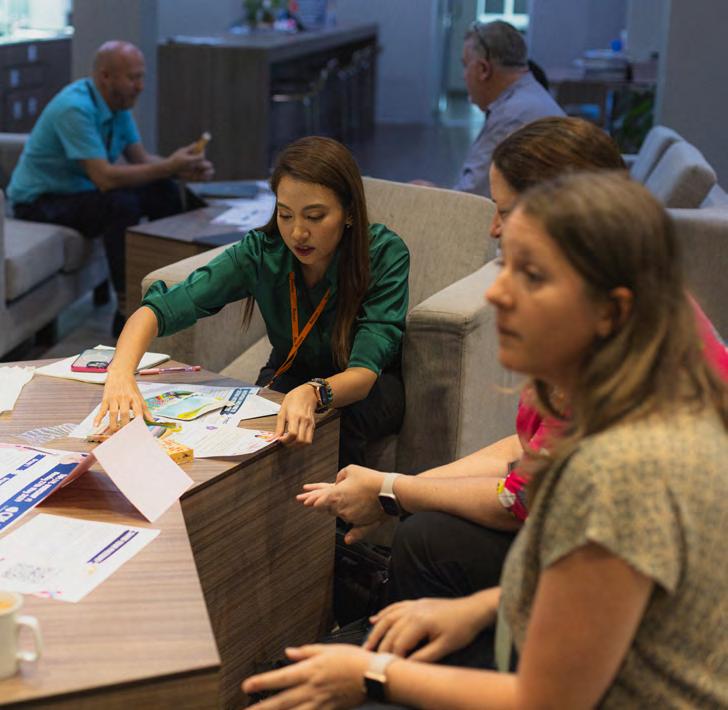


“To bring creativity back into my life and build routines where I make time to commit to art-making.”
These insights highlight the clear benefits of creative programmes like TAPs on well-being and professional development.
Over the course of the project, TAPs creatives participate in three ‘Learning 4 Learners’ workshops designed to spark intentions, foster connections, share inspirations, celebrate progress and support each other in achieving exhibition goals.
Our first workshop in May 2024 ignited creativity as participants shared their exhibition intentions and celebrated a rich variety of artistic practices—ranging from textiles, photography, painting, music, embroidery and creative writing to sculpture and filmmaking—while focusing on sustaining artistic production amidst busy schedules. Participants explored creative influences, brainstormed ideas and developed draft vision boards and initial action plans.
In our second workshop (September 2024), staff showcased their artworks in progress from the summer and reflected on how these experiences are influencing their professional practices. This dynamic atmosphere encouraged discussion of artist

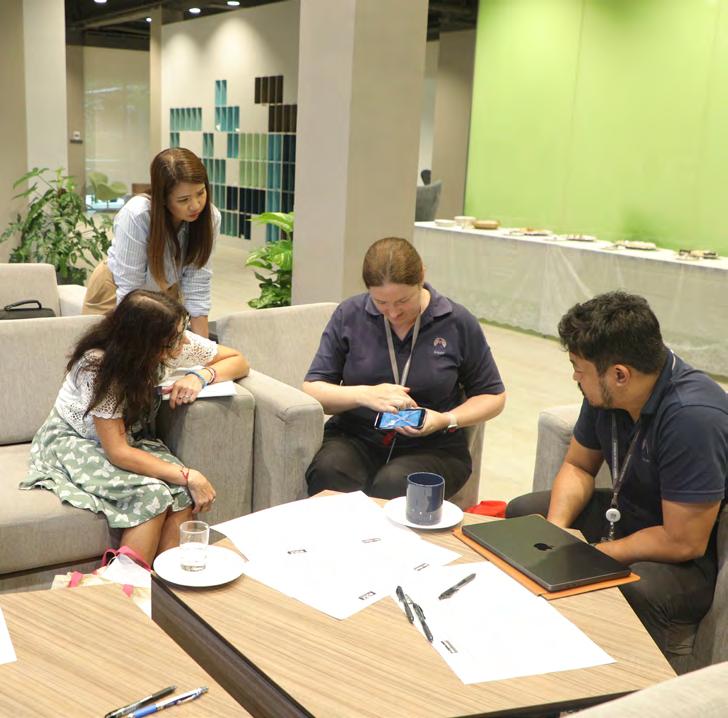
successes and challenges, whilst advancing towards exhibition goals and written artist statements, which explains their work and concept. It’s inspiring to witness the vibrant exchange of ideas across departments and faculties.
Our third workshop in January celebrates our final creations, with participants sharing their artist statements and reflecting on their growth during the CPL programme, ahead of the exhibition launch!
Throughout, many participants have been enthusiastically sharing updates on experiments, triumphs and sources of inspiration on our MS Teams channel.
“Despite being busy, I enjoy connecting with other TAPs members, sharing our artwork and passions. The supportive environment encourages me to experiment and think outside the box. The feedback has improved my skills and boosted my confidence to explore new materials and styles.” - Arunee Sribhibhadh, Secondary Thai Teacher
“Meeting with other like minded professionals has helped me ‘bridge some gaps’ within the HUGE Patana community - as a Year 3 teacher, we never really venture outside of our own little world, so it’s been an amazing opportunity to meet some new faces! We all share the same urge to create, so it’s fun to just get together!” - Ian McDonald, Year 3 Class Teacher



One of the most exciting aspects of TAPs is the diverse range of creative work emerging from the programme, which will culminate in an inaugural exhibition. The wider community will be invited to view these creations, spanning visual art, photography, filmmaking, creative writing and more, showcasing exploration, learning and sometimes stepping outside comfort zones.
“I have enjoyed the time to focus on my own creative work and it has been rewarding to share my ideas and progress with others. The final exhibition helps to keep focussed. I am sharing my progress with my classes, so they can see me going through the same steps and challenges as them.” - Ross Corker, Curriculum Leader Arts, Secondary Art Teacher
“Over the ten years I have been sewing, I thought I was the only one happily practising the craft. When I met the other participants at TAPs, I got the idea that my fabric can reflect Thai tradition and identity, so I started to create items using Thai Fabrics. It’s beautiful, unique and represents the Thai Heritage that I am very proud of.” - Sathita Kitcharoenthumrong, General Librarian, Secondary
We are thrilled to announce our inaugural International TAPs Exhibition, “Patana Canvases: Unveiling the Artistic Practices of Our Community,” running from Wednesday, 29th January

to Friday, 7th February 2025 at the Exhibition Hall, Arts Centre. The launch party will be held on Friday, 31st January
This exciting event will feature a curated showcase of our staff’s incredible artistic talents across mediums, reflecting their personal and professional journeys. Join us to celebrate creativity and enable artists the opportunity to present their work to the whole school community, along with a published exhibition catalogue that highlights their diverse inspirations and contributions.
In its inaugural year, TAPs has not only inspired participants to create but also forged meaningful connections among likeminded creatives. What is truly rewarding is witnessing how art transcends barriers of language and culture, uniting individuals from diverse departments and backgrounds through the shared joy of creativity.
As we reflect, it’s essential to consider how we can nurture artistic pursuits and further embed a dynamic culture of creativity and collaboration within our educational environment. We should explore how the power of arts can build a harmonious balance between teaching, work, art-making, and our individual lives. Through innovative ideas and shared experiences, we can unlock new pathways for growth as creatives, enhancing well-being and new connections.
You can stay updated on our project through the TAPs newsletter and school communication channels.


By Jeanne Webert and Pitcha (Pin) Tangtrongchitr, Students

Jeanne from Year 10 and Pin from Year 13 participated in the first ever Women’s team from Thailand in Touch Rugby World Cup.
Touch or Touch Rugby, or Touch Football, or Touch Footy, is a popular sport in Australia, New Zealand and the United Kingdom. It’s not well known yet in Thailand but our team’s participation in the World Cup this summer will certainly help the Thailand Touch Association develop the sport over the country. I started playing touch rugby in Australia when I was 9 years old. When I returned to Bangkok, I trained at school with the JV and Varsity teams. Pin started playing when she was 13 years old. Then I shortly started attending training outside of school with the women’s Thai team. Pin eventually joined in December of 2023. Usually, this team meets monthly for four to five hours long training camps. On top of those ‘big’ trainings, most of the players in the team play social touch weekly or twice a week. During trainings, coaches would guide us and teach us ways of improvement for each player as well as for the team as a whole. The main targets for the team were the Asian Cup
in Fall 2023 (Malaysia) and then the World Cup in July 2024 (England). Unfortunately, the Federation of International Touch had to cancel the Asian Cup. All our energy was then aimed towards the preparation for the World Cup.
In January 2024, Pin and I were lucky enough to receive a letter of selection to play for the Thailand Women’s Open team at the Touch World Cup. What a joy it has been! I couldn’t believe it. In total, we were 16 female players selected among a much bigger batch, there were a few girls that were still in school while others were in their thirties. Since the selection of the squad, we have trained even harder. On top of our long training camps, we followed weekly intense conditioning sessions and one of our coaches prepared personalised and very detailed fitness program for each of us to work out daily, overcome our weaknesses and improve our strengths. From January to June 2024, the preparation has been intense and




challenging. However, we all kept our spirits high and never gave up. Our three coaches (Joe, Dan and Daf) as well as our team captain (Val) always found the right words to talk to us and motivate us.
Thanks to the help of our sponsors, on July 13th, 2024, we arrived in Nottingham, UK well equipped with beautiful kits. Even though we were tired by the long journey from Bangkok, the jet lag and the cloudy sky, we all had smiles on our faces. We settled at one of the halls on the grounds of Nottingham University. Our dorm was great and clean, the rooms were spacious and we were all together.
Our coaches organised our trip very well, so we all have great memories. All our days and evenings were busy, from touch training with the Chinese mixed team to pizza dinner, to fun quizzes, good music and even a Thai food dinner one evening. This was all to reinforce our closeness and team spirit. We were even given dietary advice regarding what and when to eat to keep ourselves strong and make sure we don’t injure ourselves. Each member of the team had a role and we took the programme very seriously.
On the afternoon of July 15th was the opening ceremony. It was a very emotional moment. Thailand had sent only one team to the Touch World Cup, for the first time in history - a women’s team and we were part of it! It was a massive event: 187 teams from 39 nations competing across 13 divisions with
a total of 1100 games planned. We did not realise it would be that big until we saw it. It was a beautiful ceremony. Flags were dancing everywhere. Every player from every country was proud and happy to participate. A lot of supporters were there too. The atmosphere was friendly and respectful and it stayed the same during the whole competition.
We were in the Women’s Open category, competing against women of all ages. Our first game was on July 16th against Hong Kong. We played 10 games from July 15th to July 21st (Hong Kong, Samoa, Fiji, New Zealand, England, Philippines, USA, South Africa, Netherlands and Ireland). Matches were two 20-minute halves and the games were challenging for us. Some teams were really fast but playing them was an experience of a lifetime. We learned a lot. I should not forget to cite the best supporters ever - our families and friends supporting us through rain, wind and sun. Some teachers from Patana even came to cheer on us!
Joe, our Head Coach, told us we were going to the tournament to make nations sit up and take notice. We did it. The games, the tiredness, the soreness of our muscles, pushing ourselves to the max, the bond we created with our team, the hugs from other players, the little tokens we received from other teams, the jerseys and visors we exchanged with other players on the last days. Pin and I will keep those memories in our hearts forever.

By Matt Seddon, Secondary Principal
There are always at least two people who taste any bowl of soup that is served in a quality restaurant. First there is the chef, who continually tastes their soup while it simmers, making small adjustments along the way - adding a pinch of salt here, a dash of seasoning there - to ensure that the final dish is perfect. And then there
is the customer, who only tastes the soup when it has been perfected and served to them. The chef is focused on refining and improving, while the customer experiences the final product. This analogy, drawn from the educational researcher Dylan Wiliam, offers a clear way to think about the two types of assessment in schools: formative
assessment is like the chef tasting the soup, while summative assessment is the beautiful final dish.
In education, both types of assessments are crucial, yet formative assessments often receive less attention despite their critical role in fostering student growth.
In education, summative assessments provide a final judgment of a student’s learning at a specific point in time. I think of (I)GCSE and IB exam results as the ultimate summative assessments in our Secondary School—moments where the ‘final soup’ is tasted and graded. However, in a student’s typical day at school, most assessments are formative in nature. These assessments are less about providing a final grade and more about shaping the next steps in the learning journey.
Formative assessment tools allow teachers to check students’ progress and adjust their teaching accordingly. These assessments, such as low-stakes quizzes, peer feedback sessions, classroom discussions, or end of unit tests, are designed to inform teaching and help students improve continuously. At Bangkok Patana, these assessments are integrated daily into our classroom activities.
Why is formative assessment so crucial? Quite simply, it’s because learning is not linear. Students don’t make steady progress all the time; they have peaks, plateaus, and sometimes setbacks. Formative assessment allows teachers to meet students where they are, providing them with the guidance and feedback they need to keep moving forward. It’s an ongoing process that focuses on growth, rather than just the final product.
At Bangkok Patana, formative assessments happen all the time, often in ways that students may not even realise. From an engaging activity at the start of a lesson, designed to gauge understanding, to detailed feedback on a piece of home learning, every opportunity for feedback is an opportunity for growth. This continual process of assessment and adjustment is at the heart of how we help students develop not just academically, but also as reflective, independent learners.
Formative assessments support student well-being by creating a learning
environment that values progress over perfection. This focus on growth encourages a ‘growth mindset’, where students view their abilities as improvable through dedication and hard work, as opposed to the fixed mindset that can occur when students feel that they are defined by a particular grade. Emphasising growth helps students approach learning with a healthy attitude, reducing anxiety related to achieving perfection and fostering resilience.
While academic outcomes are key, Bangkok Patana also believes that it has a responsibility to equip students for life beyond exams. Through formative assessments, students develop critical thinking, problem-solving, and self-reflection skills, which are essential in the broader context of life and work. This mindset prepares them for future challenges, not just academic tests.
Research underscores the effectiveness of formative assessment. Wiliam’s work in Inside the Black Box (Black & Wiliam, 1998) demonstrates that formative assessment can significantly boost student achievement, with effect sizes indicating up to eight months of additional progress within a school year. Similarly, John Hattie’s Visible Learning (Hattie, 2011) identifies feedback — a core component of formative assessment — as one of the most impactful strategies for learning, with an effect size of 0.7. High-quality summative assessments, however, remain important for providing a final measure of a student’s progress, as highlighted by OECD reports (OECD, 2013).
Bangkok Patana’s approach to reporting uses projected grades, reflecting a commitment to formative assessment. Rather than reporting current grades, teachers forecast where students are expected to be by the end of their courses, taking into account all formative assessments. This method acknowledges that students’ academic journeys are dynamic and helps students and parents look beyond immediate scores to a long-term view of likely performance.



Bangkok Patana students consistently achieve outstanding results in their (I)GCSE and IB summative assessments, and they are the culmination of our commitment to continuous improvement. By continually focusing on formative assessments and projected grades, the school supports students in realising their potential, preparing them for future success not only academically but also as adaptable, reflective learners. This approach ensures that our ‘soup’ of education is always refined and delicious, benchmarked against rigorous global standards, and refined through continuous formative development.
By Iain Murphy, Head of Faculty, Secondary EAL at Bangkok Patana School
At Bangkok Patana School, the Secondary EAL department has always embraced innovative approaches to help students thrive in a multilingual learning environment. One of the most significant challenges for English as an Additional Language (EAL) learners is the acquisition of academic vocabulary — a vital factor for success not only in language classes but across the curriculum. To address this challenge, our EAL department has introduced the Bedrock Learning programme into our Key Stage 3 classes, with a focus on building academic vocabulary in a structured, engaging and impactful way.
For EAL students in Key Stage 3, mastering English vocabulary can be particularly daunting. Many of our students are fluent in conversational English but struggle when it comes to more complex academic language. These gaps in vocabulary can hinder their ability to engage fully with the content of their lessons, particularly in subjects like science, history and geography, where subject-specific terms are prevalent.

The challenge is twofold: not only do EAL students need to expand their word bank, but they must also learn how to use these words in the appropriate academic contexts. This is where the Bedrock Learning programme comes in. It offers a systematic way to introduce, reinforce and embed academic vocabulary through interactive lessons and activities.
The decision to implement Bedrock Learning was driven by the programme’s focus on academic vocabulary, its researchbased methodology and its adaptability to students’ individual needs. Bedrock Learning is an online, digital and adaptive platform. This means that it provides students with a differentiated, personalised learning experience by diagnosing their current vocabulary knowledge and then tailoring lessons to bridge gaps and reinforce understanding. Its intuitive platform, engaging content and clear links to our school’s curriculum goals make it the ideal tool for our EAL students.
From a pedagogical perspective, Bedrock’s emphasis on both passive and active vocabulary use was key in our choosing to introduce it. Many EAL students are familiar with a wide range of English words but may not have the confidence to use them in writing or speaking. Bedrock tackles this by requiring students to apply new words in context, ensuring they can move beyond recognition and towards productive mastery. Furthermore, the ‘mapper’ function in Bedrock allows us to import Tier 2 and Tier 3 vocabulary directly aligned with the British curriculum, ensuring students learn relevant academic language. Additionally, it offers the flexibility for us to author custom lexical fields tailored to Patana-specific topics across various subjects, enhancing targeted vocabulary instruction.

The introduction of Bedrock Learning into our Key Stage 3 EAL classes began with a careful planning and trial phase, in which we assessed our students’ existing vocabulary levels and mapped out how the programme would fit into our curriculum. Bedrock Learning could be easily integrated into our existing timetable, with students completing two Bedrock lessons per week, one in class and one at home.
Each Bedrock lesson introduces students to new vocabulary words through a variety of activities, such as reading passages, gap fills and comprehension exercises. The platform then provides opportunities for students to practise using these words in different contexts, both written and oral. One of the standout features of Bedrock is its use of spaced repetition, which ensures that students regularly revisit previously learned words to cement their understanding.
While Bedrock Learning provides an excellent foundation for vocabulary acquisition, we understand that lasting progress requires embedding these words into students’ long-term memory. To achieve this, we integrate strategies from the Great Teaching Toolkit, particularly its focus on embedding learning through repetition, review and application. One of the core principles we have employed successfully is spaced retrieval, a technique that encourages students to recall information at increasing intervals over time. In our Key Stage 3 classes, this means returning to key vocabulary words regularly through quizzes, class discussions and writing tasks. For instance, if students learned the word ‘evaluate’ in Week 1, we would include it in discussions on different subjects throughout the term, asking students to ‘evaluate the success of a historical event’ or ‘evaluate the effectiveness of a science experiment.’
The implementation of Bedrock Learning has had a marked impact on both student engagement and academic progress in our Key Stage 3 EAL classes. Regular use of the platform has boosted students’ confidence in using academic vocabulary, and many have reported feeling more comfortable participating in class discussions and completing written assignments.
Moreover, the programme has fostered a sense of ownership over learning among our students. Many have taken pride in their progress, regularly checking their Bedrock scores, striving to improve and earning much-valued House Points along the way! This self-directed approach to vocabulary acquisition has been a powerful motivator, particularly for students who may have previously lacked confidence in their language skills. Parents and guardians, too, can track and monitor their children’s progress and development from home, and receive reports on a weekly basis.
Looking ahead, we plan to continue building on the success of Bedrock Learning by further integrating it into our curriculum. In addition to Key Stage 3, we are exploring ways to offer the programme’s use to non-EAL students in Secondary, ensuring that all students have a smooth transition in their vocabulary development as they progress through their education.
Overall, the introduction of Bedrock Learning has been an innovative and highly effective way to support our EAL students in developing the academic vocabulary they need to succeed. As our department continues to explore new ways to enhance language acquisition, we remain focused on providing our students with the skills and confidence to excel on their academic journeys.
Patana Magazine interviewed Kiri Hart in Year 13 on completing her Gold Level in the Duke of Edinburgh International Award.
Achieving the prestigious Gold Level International Award is more than a mere accomplishment for Kiri—it’s a symbol of resilience, discovery and personal growth. “[The] Gold [Award] is such a milestone to achieve, and the feeling of accomplishing it is nice,” she muses, with a smile that hints at the trials behind her triumph.
The journey was far from smooth. As she recounted her expedition during the practice hike in Khao Yai, it became clear that nature had its own plans. “It was rainy season, and my shoes fell apart; the glue just gave way. I had to borrow trainers from the ranger,” Kiri says, laughing at the memory of her misadventure. But the real

trial came later, during the assessment in Chiang Rai. Five gruelling days of hiking with heavy packs, pitching tents, and pushing past mental fatigue challenged every participant. “The mental side is hard,” she admits, “But we lifted each other’s spirits—it’s a really good learning experience.”
Yet, it wasn’t all struggle. The Gold Award programme offers a multifaceted journey, requiring dedication in areas of creativity, physicality and service. Kiri’s love for swimming, already nurtured through her school team, carried her through the physical requirement. For creativity, it was baking—a passion she embraced fully, turning weekends into moments of
flour-dusted joy. “My mum is Japanese, so I also learned to make some Japanese dishes. It’s something I still do to destress from IB.” Her commitment to service was equally notable, through her work with the World Food Programme, where she served as her school club’s treasurer. “It’s given me skills I’ll carry into university.”
Perhaps most eye-opening was her residential project in Scotland. “I worked at a food pantry for the first time,” she recalls, her voice thoughtful. “It was really eye-opening, seeing how much need there is. I enjoyed every moment of it.”
But why pursue Gold after Silver? For Kiri, the answer was simple: “I finished Silver and thought, why not? I wanted to


make deeper connections with my friends.” These connections forged during moments of exhaustion, enjoyment and survival created unforgettable memories.
As Kiri talks about the impact of the award on her outlook, there’s a spark in her eyes. “If I did DOE (Duke of Edinburgh’s) Gold, I feel like I could achieve anything.”
From an enthusiastic student to an avid outdoorswoman, her love for hiking is now ingrained. “Now, when I go on holiday, I want to go hiking. It won’t be as hard as what I’ve already done,” she said. That endurance, that grit—it’s evident that the experience changed her, instilling a new appreciation for nature and adventure.
The Gold International Award isn’t just a line on Kiri’s university application—it’s a testament to her perseverance, adaptability, and evolving sense of self. For anyone contemplating their own Gold journey, Kiri’s advice is clear: “Be mentally prepared and surround yourself with friends who lift you up. Just enjoy it. You’re making memories that will last a lifetime.”
In the end, it wasn’t just the award she carried home, but a profound sense of achievement. “There were times I wanted to go home, but when I made it back to camp, I felt relief and happiness. I made it through. I was safe. I was alive.”
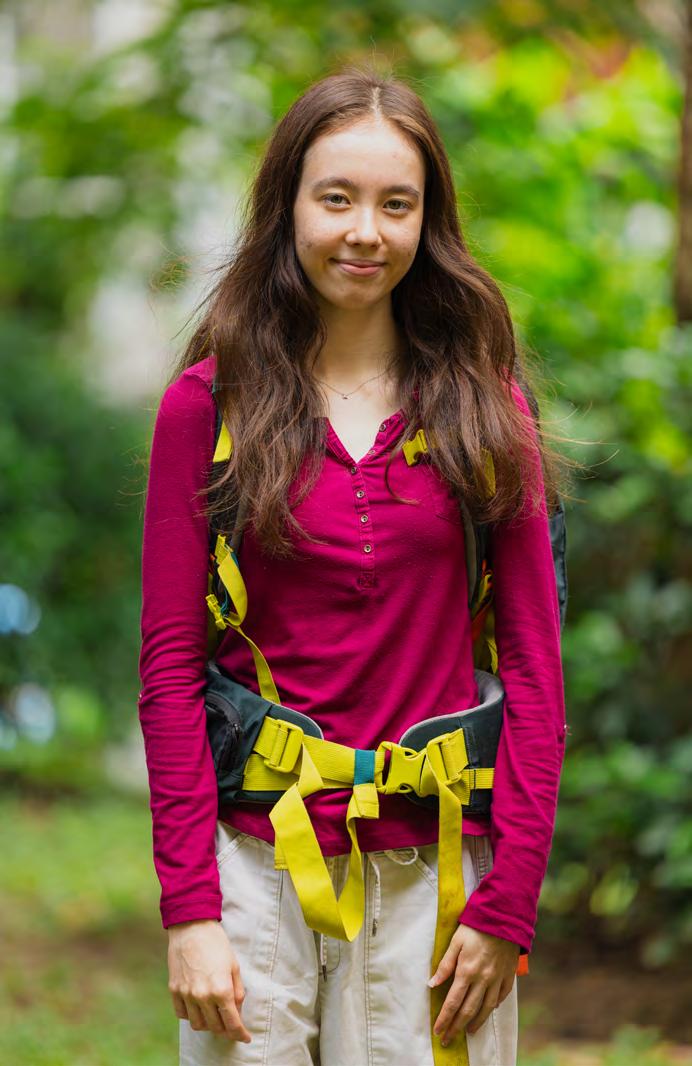



By Elliott Tooley and Scarlett Sloane, Year 11 Students
At the end of Year 11, we were fortunate to finish our exams early, leaving us a month before the summer holidays began. We decided to volunteer at Thomas House. This was to be three weeks away from our homes and parents - the longest time for both of us - lodging in a homestay and working with children at Thomas House. We were excited while also a little nervous about our new freedom and responsibility.
Thomas House is a centre for children of all ages with special needs, which provides education and support to ethnic minorities who lack access to government funded centres.
Three days after our last exam, we said goodbye to our families at Suvarnabhumi airport and embarked on our memorable adventure. Arriving at Chiang Rai Airport,
we were greeted and driven to Maekok River Village Resort, two hours northwest of Chiang Rai, next to ThaTon town near the Myanmar border. We met with Rosie who (with her husband Brian) manages donations and volunteers at Thomas House. She introduced us to our host, Khun Aree and we settled into our new home. Our room was spacious and comfortable, although we were a little worried about the lack of air conditioning… The homestay was in a beautiful garden that looked out onto the temple on the hill, home to many chickens and an antisocial cat. The next day (Sunday) she showed us around the town and neighbouring village.
The following morning - our first day at Thomas House School - we were introduced to Kru Joy, the Headteacher,

Tabi (another British volunteer there), and the children we would be working with for the next three weeks. The pupils are of varying ages and abilities with the youngest being three years old (Doi), and the eldest being 27 (Phai); she also helps out with the children, of whom there are about fifteen in total. The range of disabilities included: down syndrome, severe autism, fine motor issues, speech, vision and hearing impairments as well as children with severe learning needs. There are of course those who just have to be very closely monitored due to medical conditions which could potentially cause serious injury if not supervised, such as epilepsy. The children were on their best behaviour when we first arrived and greeted us with big smiles. However, by the second week, they had become



used to us and they started to be a little cheeky.
A typical day consisted of us waking up at 6:30am to get ready and have breakfast before the bus arrived around 7:55am for a 9:00am start. An average daily routine at the school started with free time when the children could either read, dance, or play. We then stood for the national anthem and the raising of the flag which was followed by circle time where we sang our morning songs; the children sang enthusiastically and performed the actions before we presented the weather, days of the week, and the rules via laminated cards containing pictures and words. We would say the words in English and they would dutifully repeat back in English and Thai. After that, it was snack time which was


followed by stretching/dancing videos in one of the two classrooms where we would assist anyone struggling or lead as an example. Some of the children were less than enthusiastic about the stretching exercises and made it known they did not wish to be there!
Following this there were more formal lessons, on Mondays and Tuesdays Kru Joy took them for Thai where they would practise reading and writing; Wednesday was sports which we shared leading; and Thursday and Friday was English. The children had lunch while we cleaned and set up the afternoon activities and then we had lunch while they napped or relaxed. This was nice and much needed downtime for us as well as getting to know Tabi more. The afternoon activities varied day by day but often included colouring, painting and bracelet making, which helps to improve their motor skills as well as skills needed for everyday life. One of their favourites was rock painting; they enjoyed painting and mixing to create different colours and they especially enjoyed painting their hands! We then had circle time again where we sang our afternoon songs followed by snacks and free time to either read or play. We played with the children until the bus arrived to pick us up at about 3:00pm every day.

Working with the children was very strenuous and tiring as you must be constantly concentrating and ‘performing’ while managing their behaviour, interactions and keeping them on task! It is also extremely rewarding and enjoyable. After finishing our (I)GCSEs, this was an incredible experience to have had during our summer holidays.
Our three weeks up north helped us become more confident, resilient and selfsufficient due to the need to be responsible for ourselves. Our interactions with the teachers were lots of fun as we don’t speak fluent Thai and they don’t speak fluent English. This brought us closer because of us laughing together while using Google translate. The afternoons playing with the children before our bus took us ‘home’, though hectic, were one of our highlights throughout the experience.
We are both so incredibly lucky to have been able to do this and give back to the country we have both grown up in. Coming from a very privileged school such as Bangkok Patana it was enlightening and humbling to see the contrast between our school facilities and theirs. Because of this amazing experience, we have decided to set up a CAS club which aims to support and raise money for Thomas House to raise funds for supplies and equipment for the children as well as maintain this invaluable opportunity for them. We are keeping in contact with Rosie and Brian who we are most thankful to, for helping us do this and so we can now help Thomas House.
If you would like to donate to Thomas house please contact Rosie@mrveducationservices.com and if you would like to help with the CAS club please contact scsl26@patana.ac.th or emto26@patana. ac.th














Siranudh (Psi) Scott’s (Grad’14) journey has been anything but conventional. From the glitz and glamour of Los Angeles to the sun-drenched shores of Thailand, his path reflects a deep inner calling to change the world—one swim at a time.
It all began in LA, where Psi pursued animation. Yet, despite the allure of the entertainment industry, something gnawed at him. “It wasn’t fulfilling all the things I had been raised to care about,” he reflects. The world of film felt insular, detached from the global issues that had long captured his attention. “I was concerned about politics, world affairs, and I wanted to make a difference. But in LA, it was so narrow-focused solely on their programmes.”


Feeling increasingly confined, Psi craved something more. When the pandemic hit, he knew it was time for a change. “I had this strong desire to come back to Thailand, stay by the ocean. It felt like an opportunity to start afresh.” And in the turquoise waters of Thailand, Psi rediscovered his purpose. “All I wanted to do was swim. I found pools depressing, I needed the ocean.”


Back home, Psi’s academic background in geography and environmental systems came to the forefront. He was struck by how the environmental issues he had studied in global case studies were now playing out in Thailand. “I had a sense of pride in Thailand and wanted to protect it,” he says. But this wasn’t just an abstract concept. He dove right in, meeting with local officials, including the


mayor. “No one respected enough was talking about it,” he recalls. There were no role models, no established path to follow. “I knew I was on the right track, but I didn’t have anyone else to stand with me. I’m a firm believer in leading with my heart, and I’ve found others who do the same.”

Psi’s environmental work began to take shape through both passive and active efforts. His fame as a swimmer, earning him the moniker of “Aquaman” or “Merman”, opened doors for his activism. Swimming long distances, such as a grueling 17–20 kilometres across the ocean in Krabi in 2022, was not just about physical endurance. “I didn’t set out to torture myself,” he chuckles. “But it was about balancing, respecting who you are and nurturing all parts of you.”


His swimming expeditions became symbolic of a larger mission. Psi forged close relationships with Thailand’s national park rangers, and his ocean swims were not just solo endeavours—he often had
the support of park groups, swimming alongside him. “They do what I do, but on a different scale. I’ve built great relationships with the rangers.”
In his environmental work, Psi embraces a philosophy that is both practical and inspiring. “Most of the pollution comes from human convenience,” he says, with a note of frustration. “Simple things like plastic bags, they are the most narcissistic invention ever!” he exclaimed. He advocates for small, thoughtful changes, like choosing public transport over private vehicles or considering where your food comes from. But most importantly, he believes in leading by example. “There’s no point in knowing something if you don’t follow through,” he states firmly.
Psi’s influence stretches beyond the beaches he helps clean. Studying at Bangkok Patana, he recognises the bubblelike environment such schools can create. “It provides a glimpse of what could be. You can talk about these issues, and it reminds us that our bubble interactions can take form outside of it.” His hope is to inspire others to take action, whether in small daily choices or larger environmental efforts. For Psi, it’s not about asking others to do something foreign. “I’m not asking them to do something alien. I am validating that voice within them,” he said.



From LA to Thailand, from animation to environmental activism, Psi Scott has charted a path uniquely his own. Whether swimming the open ocean or speaking out against pollution, his journey is a testament to following one’s heart, trusting the process, and leading by example.






